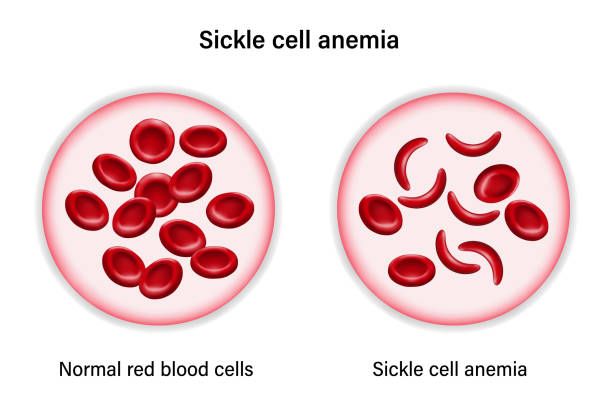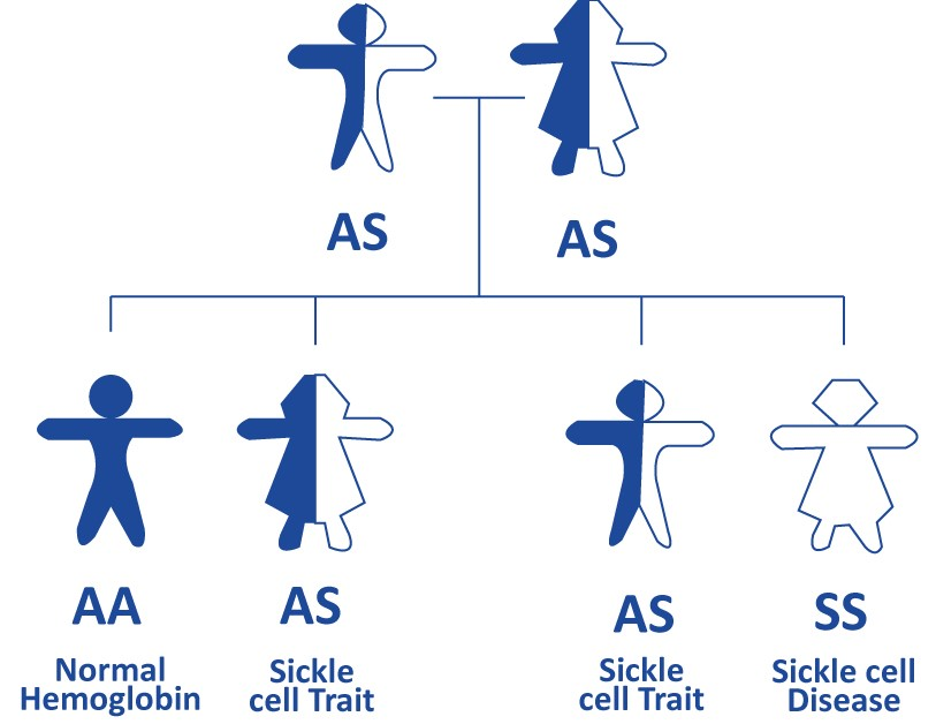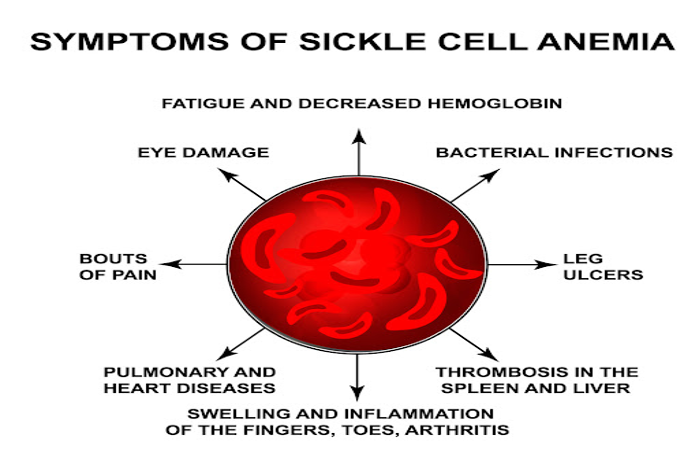FAQs
Sickle Cell Disease is a genetic blood disorder inherited from both parents. People with healthy red blood cells carry oxygen to all the parts of their body through small blood vessels, but a person who has Sickle Cell Disease the red blood cells become hard and sticky and look like a C-shaped form tool called a “sickle.” The sickle cells die early, causing a shortage of red blood cells. Additionally, when they travel through small blood vessels, they get stuck and clog the blood flow. This can cause pain and other serious problems such infection, acute chest syndrome and stroke.

WHAT CAUSES SICKLE CELL DISEASE
Sickle cell disease is a genetic condition that is present at birth and is inherited when a child receives two sickle cell genes from each parent. When the child inherits hemoglobin S gene from one parent and a normal gene from the other parent, oftentimes they have the sickle cell trait and carry the sickle cell disease.
WHAT IS SICKLE CELL TRAIT
Sickle cell trait is a person who carries a single gene of sickle cell disease and transfers the gene to their child. Sickle cell trait occurs when a person inherits a gene for sickle cell beta globin from one parent and a gene from a normal beta globin from the other parent, which means the child won’t have the sickle cell disease, but the trait. People with sickle cell trait do not have any symptoms and usually live a normal life. People with the sickle cell trait have both normal and abnormal hemoglobin.
Hemoglobin is found in the red blood cell and is made from two similar proteins, one called alpha-globin and beta-globin, which stick together and both proteins must be there and function properly for the hemoglobin to function.
SICKLE CELL TRAIT

WHO IS AFFECTED BY THE DISEASE
The Centers for Disease Control and Prevention estimates that sickle cell disease affects more than 100,000 Americans in the United States however, the exact number of people with sickle cell disease is unknown. Sickle cell disease is a genetic disease that has severe effects on adults, families and children in a severe form that impacts the individual physically, socially and psychologically, and it is one of the most deadliest genetic diseases. People with the disease can experience severe pain, anemia, organ failure, stroke, and infection resulting in a 25 to 30 year reduction in life expectancy.
HOW DO I KNOW IF MYCHILD HAS SICKLE CELL DISEASE
Sickle cell disease is detected at birth through a blood test which involves a newborn routine screening. Also, there’s a second blood test called a hemoglobin electrophoresis that can confirm the sickle cell diagnosis. Sickle cell disease can be detected before birth by testing amniotic fluid or placenta tissue.
SYMPTOMS OF SICKLE CELL DISEASE

IN ADULTS SICKLE CELL CAN CAUSE:
PREGNANCY LOSS
INCREASE HIGH BLOOD PRESSURE
BLOOD CLOTS
LOW BIRTH OR LOW BIRTH RATE BABIES
WHAT SHOULD YOU DO IF YOUR CHILD HAS SICKLE CELL DISEASE
- THE CHILD SHOULD REMAIN HYDRATED WITH FREQUENT AMOUNTS OF WATER TO PREVENT HYDRATION
- THE CHILD SHOULD DRESS PROPERLY DURING HOT AND COLD WEATHER
- IF THE CHILD GET INJURED, AVOID USING ICE PACKS AND APPLY WARM COMPRESSES
- KEEP THE CHILD UP TO DATE WITH VACCINES AND FOLLOWS ALL RECOMMENDATION
- DURING EMERGENCY HAVE THE CHILD TAKE OVER COUNTER MEDICATION SUCH AS IBUPROFEN, ACETAMINOPHEN. PRACTICE RELAXATION TECHNIQUES WHICH CAN HELP, BUT IF THE PAINS DOESN’T IMPROVE, TAKE THE CHILD TO HOSPITAL FOR PAIN MANAGEMENT
- CHECK WITH THE CHILD HEALTHCARE PROVIDER REGULARLY AND KEEP TRACK OF THEIR SYMPTOMS
- EDUCATE THE CHILD NOT TO SMOKE, DRINK OR USE DRUGS
- ENCOURAGE YOUR CHILD TO GET REGULAR EXERCISE, BUT TAKE REST BREAKS
TREATMENT FOR SICKLE CELL DISEASE
The only therapy approved by the FDA that may be able to cure SCD is a bone marrow or stem cell transplant.
Bone marrow is a soft, fatty tissue inside the center of the bones, where blood cells are made. A bone marrow or stem cell transplant is a procedure that takes healthy cells that form blood from one person—the donor—and puts them into someone whose bone marrow is not working properly.
Bone marrow or stem cell transplants are very risky and can have serious side effects, including death. For the transplant to work, the bone marrow must be a close match. Usually, the best donor is a brother or sister. Bone marrow or stem cell transplants are most common in cases of severe SCD for children who have minimal organ damage from the disease.
HEALTHY FOODS AND VITAMINS
ACCORDING TO EAT RIGHT.ORG- PEOPLE WITH SICKLE CELL DISEASE MAY BENEFIT FROM HEALTHY EATING FOOD THAT ARE RICH IN VITAMINS AND MINERALS, WHICH INCLUDES
- ZINC IS ESSENTIAL FOR CHILDREN WITH SICKLE CELL THEY MAY NEED ZINC MORE THAN OTHER CHILDREN. ZINC IS FOUND IN FISH, SEAFOOD, BEANS EGGS, LEGUMES DAIRY PRODUCTS, WHOLE GRAINS
- FOLIC ACIDS HELPS REPLACE RED BLOOD CELLS RESULTING IN FASTER BREAK DOWN IN PEOPLE WITH SICKLE CELL. FOLIC ACID IS FOUND IN LEAFY GREEN VEGETABLES, FRUITS, DRIED BEANS AND PEAS, BREAD, CEREALS, FLOURS, CORN MEALS, PASTAS, RICE AND OTHER GRAIN PRODUCTS
- VITAMIN A HELPS WITH EYESIGHT
- VITAMINS C AND E ARE ESSENTIAL FOR THE IMMUNE SYSTEM
- MAGNESIUM FOUND IN SPINACH, MUSTARD GREENS AND PUMPKIN SEEDS
- VITAMIN B CAN HELP PREVENT ANEMIA
- PHOSPHORUS FOUND IN ALMONDS, TENTILS, MILK, YOGURT, CHEESE, EGGS, BEEF, CHICKEN, TURKEY, AND FISH
- CALCIUM IS FOUND IN SPINACH, MUSTARD GREENS, COLLARD GREENS, TURNIP GREENS, KALE, ORANGES AND SALMINS
TREATMENT OPTIONS TO DISCUSS WITH YOUR PROVIDER
GENE THERAPY
Gene therapies like Casgevy and Lyfgenia are available for patients from aged 12 and older. Treatment used by the person's own blood stem cells.
PAIN MEDICATIONS
hydroxyurea, voxelotor, crizanlizumab, and L-glutamine. Hydroxyurea is by oral intake medication that can prevent the frequency of pain crises. Voxelotor is used to improve anemia and blood flow. Crizanlizumab is an injectable medication that reduces pain crises in adults and children over 16 and L-glutamine is an oral powder that can help lower pain crises.
BLOOD TRANSFUSIONS
Can help treat complications such as anemia, stroke, chest syndrome and ulcers
Your support can make a difference
Consider contributing as little or as much as you can. Every dollar donated goes toward keeping our programs and SCD efforts- alive.
We collaborate with community partners, including Brown University Health, local blood drives, and the American Red Cross, to raise awareness about blood donation and its importance. Our efforts focus on educating the community about the donation process and providing critical support to individuals affected by sickle cell disease. Please consider donating and joining us in making a meaningful impact in the community.
All Rights Reserved | Caleb Duplan Foundation
